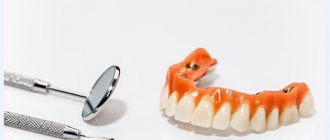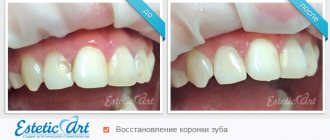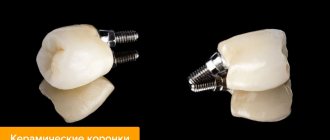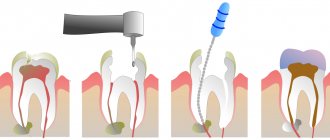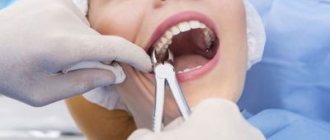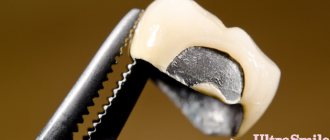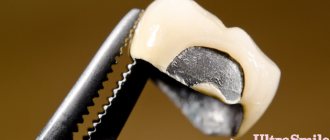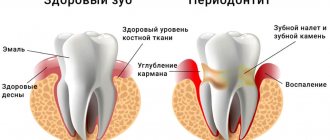Indications and contraindications for tooth augmentation
Teeth augmentation is a multi-stage technology for restoring the aesthetic appearance and functions of the jaw, which was susceptible to chipping or erased as a result of increased tone of the masticatory muscles, called buxism.
Indications for the tooth augmentation procedure:
- chips resulting from injuries;
- numerous caries lesions;
- large distance between teeth;
- wedge-shaped defect;
- the presence of a gap between the two front teeth;
- congenital structural pathologies;
- thinning and demineralization of enamel due to consumption of junk food and lack of oral hygiene;
- cervical caries;
- the presence of errors in previous dental sessions that resulted in the destruction of healthy tissue;
- malocclusion.
Having asked the dentist a question about what tooth extension is called, the patient will immediately hear the answer. The procedure is called dentition restoration. Modern extension technologies make it possible to restore the structure in most cases without resorting to its removal. The procedure is harmless, but has a number of contraindications:
- patient age – more than 60 years;
- children's age when using pins;
- presence of a cyst;
- inflammation of the gums;
- pregnancy in the first or third trimester;
- failure to comply with personal hygiene rules;
- periodontitis and stomatitis;
- jaw fracture and other injuries.
If a patient is diagnosed with diseases that are contraindications, the dentist first treats them, and then restores the dentition.
Restoration of a chipped tooth: types of treatment and restoration of damage
In restorative dentistry, various methods of tooth restoration are used, depending on the type of injury, the nature of the defect, the location of the damaged tooth and the general health of the patient. In each specific clinical case, the method of tooth restoration is determined individually, but experts identify several main types of treatment for chipped teeth.
Remineralization
Remineralization is used as a method of partial restoration of tooth enamel with small defects and microcracks, for prophylaxis, to prevent the leaching of minerals and to strengthen the outer layer of the tooth. The surface is covered with a special solution containing micronutrients and enriched with minerals. Remineralization allows you to restore the protective properties of enamel.
Remineralization of tooth enamel
Fluoridation
Fluoridation is the application of medicinal preparations in the form of gels and varnishes with a high fluorine content to the damaged surface. The procedure is carried out in several stages and allows you to restore the integrity of the enamel in case of minor damage.
Building up
Extension is carried out in cases of moderate tooth trauma with partial dentin fracture; the procedure involves applying a special medical paste, fixing each layer using light radiation. When restoring in this way, a certain texture, color and shade of the building material is selected, which makes it possible to make the restored tooth practically indistinguishable from others. This technique has a relatively low cost and is effective, which has made extensions very popular.
Filling and microprosthetics
Filling and microprosthetics are used for extensive damage to dental tissue; in various cases, restoration is used using conventional fillings, stump and restoration inlays, veneers and lumineers, and in case of tooth loss, prosthetics on implants or the installation of artificial crowns are performed.
Microprosthetics of cracked teeth
For outgoing and public people, the appearance and attractiveness of a smile is often of great importance, so a chipped front tooth can become a real problem. For the restoration of teeth located in the frontal part of the dentition, onlays made of ceramics, porcelain or zirconium dioxide can be used, which are the best aesthetic solution. When using microprosthetics with veneers, you have to grind off a thin layer of enamel to make the overlay look as natural as possible; the procedure is quite unpleasant, but allows you to achieve maximum attractiveness. Lumineers are thinner, so their installation does not require grinding the enamel, but this type of lining is more vulnerable to mechanical damage. Onlays perfectly hide tooth defects and are used not only in case of chips, but also to restore aesthetic function to patients with crooked dentition and large gaps between teeth.
When restoring lateral teeth that are hidden from the eyes of others, visual appeal and beauty often fade into the background, so restoration can be performed using inlays, the main task of which is to reconstruct the integrity of the tooth and restore chewing function. Restorative inlays perform the same function as fillings, but for more extensive damage - they replenish the damaged or chipped part of the tooth, restore the original shape and relief of the dental unit. Stump inlays work on the principle of crowns - they restore the upper part of the tooth, which has preserved the root and base, but has a large affected area. Inlays are made from noble and base metals, metal alloys, which makes them wear-resistant and durable, and ceramic, metal-ceramic and light-polymer composite inlays are used to restore the color and shade of teeth. In some clinical cases, adhesive microprostheses made of fiberglass in the form of a beam can be used, which are attached to notches on adjacent teeth using medical cement; such products are hypoallergenic, light and durable.
Installation of crowns
Very often, patients are interested in whether it is possible to build up a tooth with a vertical crack and a damaged nerve, split in half to the pulp. Despite the wide arsenal of restoration methods, the most acceptable option is the removal of the injured tooth with the subsequent installation of an implant and an artificial prosthesis.
Teeth extension methods
There are 2 main extension methods:
- Straight. Used if tooth decay is up to 30%. During the procedure, composite or photopolymer materials are used to build teeth. The former are less durable and harden after 30 minutes. The latter have a service life of 10 years and remain plastic until exposed to the lamp.
- Indirect. Applicable when damage affects no more than 70% of the structure. The method has several stages, including taking impressions, making and installing ceramic inlays.
If you have ever thought about whether a crown or extension is better, then you should know that a crown is installed when more than 70% of the tissue is destroyed, but a intact and healthy root remains.
How much does the procedure cost?
For a complete restoration of a damaged tooth, you will have to pay at least 5,000 rubles. This includes the use of painkillers (200-300 rubles), consumables that isolate the damaged tooth from saliva (approximately 400 rubles). Also, do not forget about sterilizing the set of instruments used - the cost is low, about 100 rubles, but still people often do not take this into account. The main amount spent is spent on the purchase of filling materials, which are used to build up the tooth. This is around 3000 rubles. Also, the use of technology using a pin implies the purchase of an imported product, which also costs a lot. Prices may vary depending on the clinic where the procedure is performed.
Tooth restoration using a fiberglass pin
You can save a lot by using a domestic fiberglass pin, the cost of which is 60-100 rubles. But, as a rule, they do a poor job of fixing the tooth in the root canal.
The cost of tooth augmentation may vary
Regardless of the chosen extension method or materials, the main thing is not the procedure itself, but the subsequent care. After all, what is the point of an expensive procedure if, after installing an artificial tooth, the patient does not follow the rules of oral hygiene? The main thing is to follow the doctor’s recommendations and do not forget that caring for the extended tooth affects its service life. Therefore, it (care) should not be less thorough than caring for living teeth.
Features of front teeth extensions
Restoration of anterior teeth is carried out in the following cases:
- Yellowing of enamel;
- Damage to caries;
- Minor curvature;
- Presence of chips or chips;
- Grayish-yellow coating.
Composites and photopolymers are used for extensions, but veneers are the most popular. They are used for minor damage to healthy tissue. If the tooth body is deeply damaged, it is removed from the roots and an implant is implanted in its place. Types of veneers presented in our clinic: composite veneers, ceramic veneers.
Chips of baby teeth often occur in childhood. Many parents do not pay attention to this, hoping for the speedy growth of indigenous children. This is wrong, as the sharp edges scratch the tongue, causing inflammation and infection. Children's extensions are made using composite materials and are absolutely painless.
Tooth extension onto a pin
When thinking about whether it is possible to build a tooth onto the root, the use of a pin comes to mind. It is used if both the body and the root are severely damaged.
The procedure includes:
- obtaining an x-ray;
- cleaning the mouth, removing stones;
- removal of damaged areas;
- computer tooth modeling;
- removal of saliva;
- anesthesia;
- cleaning of channels;
- implantation of a pin, cleansing the area around it;
- filling the space around the pin with a composite or photopolymer;
- polishing and grinding.
Dentists build up teeth under crowns only if the remainder is in good condition and does not rot or decompose.
Does it hurt to grow teeth?
Tooth extension is a painless procedure. Anesthesia is not performed if the damage is not significant, since manipulations are carried out at a superficial level. If the damage is severe, the dentist administers local anesthesia. Modern drugs begin to act immediately after administration.
After the session, the first day you may experience pain if the canals were cleaned. Painkillers will help you feel better.
The restored dentition will last a long time if the patient provides proper care. If the question arises about whether it is possible to smoke after tooth extensions, the answer will be negative. Composite and photopolymer materials quickly absorb all substances, which is why the filling quickly changes color. Maintaining hygiene and regular visits to the dentist will help you maintain your smile for a long time.
What should you do first if a tooth is damaged?
Of course, if you receive slight damage to the enamel or detect microcracks, you should not escalate the situation and immediately run to the 24-hour dental care office; just make an appointment with the dentist on any convenient date. But in case of moderate or severe tooth defects, it is necessary to consult a doctor as soon as possible, having first provided first aid to yourself.
Cold compress for a damaged tooth
To do this, you need to rinse your mouth with a saline or soda solution to remove any remaining food, in case of serious damage, apply a cool compress that will prevent swelling, and in case of gum injury, use a disinfectant pad with hydrogen peroxide. If the pain is severe and there are no contraindications, a painkiller will come to the rescue. And then – straight to the doctor!

